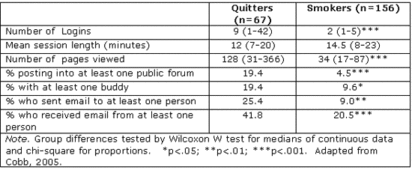Websites designed to help smokers quit are a relatively new treatment alternative. Treatment is complex and those who subscribe to online help sites deserve to know whether the approach is effective. This week’s ASHES reviews a study evaluating the online smoking cessation website http://www.quitnet.com/
The quitnet.com website offers a variety of resources, including diagnostic tools, information about medication options, social support through forums, chat rooms, and email. At registration, users provide information about their smoking frequency and motivation to quit. Cobb, Graham, Bock, Papandonatos, and Abrams (2004) invited consecutive registrants during a fourteen day window to complete a follow-up survey three months later. This survey collected information about various outcome measures, including 7-day abstinence rates, longest period of abstinence, use of other treatment resources, and, if still not quit, cigarettes smoked per day. Furthermore, these researchers monitored participant activity on the site during the three months leading up to the follow-up; observations included the number of logins, duration of each login, and which resources registrants used.

Figure. Median (interquartile range) of outcomes at 3 months and site use patterns for baseline smokers. Click image to enlarge.
Some registrants were excluded because of incorrect emails or because they never smoked. Of the 1,024 people included in the study who smoked at the time they registered, 223 received, completed, and returned the follow-up survey. Thirty percent of this group (67 people) reported not smoking for at least 7 consecutive days before taking the survey three months after registration (see the Figure). People in the sample who quit used the interactive web site support services more than people who continued to smoke. Among quitters and smokers, there were no differences in baseline smoking rate or motivation to quit.
There are a few limitations to the study results. The response rate was low, risking a selection bias, and there were no control conditions. Simply put, it is not possible to determine whether the site influenced the observed changes or whether influences that already were at work when people registered for the site services caused the smoking changes. Placing the follow-up survey at three months might not have allowed enough time to measure some who successfully quit or who might have relapsed after the three month period. Finally, the follow-up survey was based on self report, which is subject to recall and self presentation biases.
Without a control group, this study had no method to determine the role the website played in participants’ ability to quit. Although the number of survey respondents was small, 100,000 people access the site per year. This suggests that there is a demand for help online. However, whether online resources help people quit, play an ancillary supportive role, or do not help at all is still left to further research.
-Leslie Bosworth.
References
Cobb, N. K., Graham, A. L., Bock, B. C., Papandonatos, G., & Abrams, D. B. (2004). Initinal evaluation of a real-world Internet smoking cessation system. Nicotine and Tobacco Research, 7(2), 207-216.
What do you think? Please use the comment link below to provide feedback on this article.




